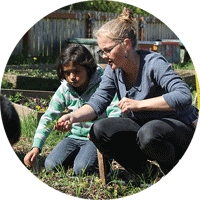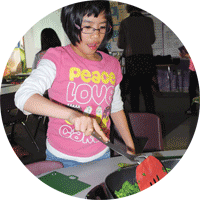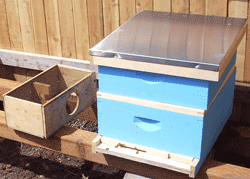Hunger to me means “where’s the nearest Chipotle?” Beyond that, it doesn’t matter where the food came from, or who got it there, as long as it ends up in my stomach. I waited in a parking lot with over 30 employees of various food banks around Seattle, wondering what they saw in food that I didn’t. We were waiting to begin a van tour, organized by Solid Ground’s Food Resources staff, of local organizations committed to alleviating hunger in the community.
I mistook this as a straightforward endeavor. People need to eat, and they can’t afford grocery stores, so let’s give them the food they need to survive. As the tour progressed, I realized that ability to pay is only a secondary and contributing issue to access. Food is fickle: It spoils, it has bad crop years, it needs nutrition expertise for a balanced diet. The economy of food relies on brilliant crop combinations, precise warehousing, and efficient distribution. In the nonprofit food world, innovative logistics are the difference between a family eating dinner or going without.
The tour took us through every gear of the well-oiled food machine, each organization fully aware of the specific role they play in bringing sustenance to people most in need of it. Although each organization wrestles with obstacles unique to their role, they all attempt to answer the fundamental question of how to allocate their limited resources to feed the most people.
Seattle Tilth Farm Works
Around lunchtime, the now bumpy roads brought us to the birthplace of food – the farm. The 39 acres of Seattle Tilth Farm Works swept us into a peaceful quiet. A few men and women in straw hats pulled wheelbarrows of crops across the shifting landscape. I felt close to my food’s roots.
Seattle Tilth has made it their mission to involve the community in farming by providing education classes, not just on farming techniques, but also on the marketing and business aspects of successful farms. After completing their education, farmers receive subsidized land based on their income, enabling people of all incomes to participate. As farmers gain proficiency with their crops, they are encouraged to scale up their land to eventually generate a livable profit. The community sharing framework helps minimize the overhead infrastructure cost that often prevents beginning farmers from getting started.
There is ingenuity behind a successful crop. One woman plants the Three Sister combination: corn fed by fixed nitrogen from the beans, protected from weeds by the squash. The farm has a similar partnership with local food banks, providing them with fresh produce, and in return, using their stale leftovers as live feed for the pigs!
Northwest Harvest
Storing and distributing foods is perhaps the most undervalued component of the food industry. We walked into the squeaky clean Northwest Harvest distribution and warehouse center. The open rooms and slanted floors are all designed to facilitate transporting mass quantities of food. As the tour guide said, the goal of the distribution center is essentially to “fill up, empty out” – referring to the millions of pounds of food they store and then distribute to more than 370 food banks every year.
Northwest Harvest is deliberate in how they organize their space. Huge, automatic doors open and close in under 90 seconds, maintaining freezing storage temperatures, and saving countless dollars of electricity and spoiled food. Towering shelves of various food products are organized in an XYZ grid to find and methodically transport items. Northwest Harvest’s relentless devotion to efficiency gives them the financial capacity to provide for so many food banks.
Emergency Feeding Program
Small-scale distribution centers can also provide an effective model. The Emergency Feeding Program does not try to operate on the same magnitude as Northwest Harvest but instead focuses their efforts. Every year, they provide 430,000 emergency meals outside of foodbank distribution hours. They provide bags of basic food supplies meant to last families one to two days. Although they neither work with the quantity Northwest Harvest does, nor offer the selection that food banks do, they provide a vital service: They deliver emergency food all over the state, and think critically about the diverse people they provide food for. They have food bags specific to different cultural communities, baby food bags, bags for specific health conditions, and bags that don’t require any refrigeration.
Des Moines and Maple Valley Food Banks
On the first stop of the tour and the last stop for the food, we visited the Des Moines and Maple Valley Food Banks. Both food banks are cognizant of distinguishing between different-sized families, creating systems that regulate how much food you receive based on how large your family is. The Des Moines Food Bank utilizes a conveyor belt process where each shopper is allowed a certain amount of items from each bucket based on their color-coded family size. The Des Moines Food Bank also implements a summer backpack program that serves carefully balanced lunch and snacks for kids at 25 sites.
The Maple Valley Food Bank is a slightly smaller operation that adopts a grocery-style format. Shoppers are allocated a fixed number of points in each nutrition category. The shoppers can browse the food bank at leisure, rather than following a linear route. Differences in food bank setups often result from different space limitations and varying levels of capacity
Every organization we visited on the tour, although independent in their purpose and methods, universally relies on partnerships and volunteers to help resource their operations. Every organization is alike in their eagerness to expand their services and the earnestness of their goodwill. The various systems come from years of adjustments to figure out how best to feed those who ask. The tour inspired me in just how seriously the organizations confront hunger, each one demonstrating that where food comes from and who delivers it determines how many stomachs it reaches.
Filed under: Food & Nutrition | Tagged: Des Moines Food Bank, Emergency Feeding Program, Food Resources, Maple Valley Food Bank, Northwest Harvest, Seattle Tilth Farm Works | Leave a comment »






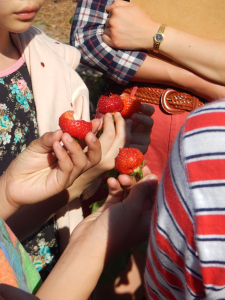 the pleasure of working with a class of fifteen 5th graders from a local after-school program. Since many of them were already acquainted with the garden – either through a previous garden class or a simple meander through the neighborhood – we were able to delve a little deeper into the heart of the garden and what exactly makes it tick.
the pleasure of working with a class of fifteen 5th graders from a local after-school program. Since many of them were already acquainted with the garden – either through a previous garden class or a simple meander through the neighborhood – we were able to delve a little deeper into the heart of the garden and what exactly makes it tick.
 Interested in a year of service? Have a passion for food justice?
Interested in a year of service? Have a passion for food justice? 




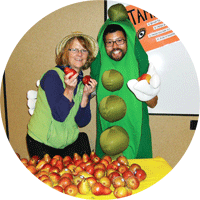 The whole idea around nutrition education is that if we can really train children from an early age in all aspects of healthy eating, in understanding the value and benefit of eating balanced, nutritional meals, if we can help children at that young age really start to fall in love with healthy foods – taste it, experience it, and see that it’s good – that enables them to start making healthier choices. That is supportive of food justice.”
The whole idea around nutrition education is that if we can really train children from an early age in all aspects of healthy eating, in understanding the value and benefit of eating balanced, nutritional meals, if we can help children at that young age really start to fall in love with healthy foods – taste it, experience it, and see that it’s good – that enables them to start making healthier choices. That is supportive of food justice.”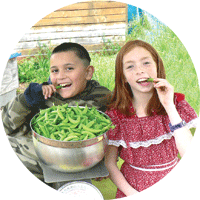 “Lettuce Link is all about being a community place where people can not only come and learn about growing food, but they can actually experience it,” Gerald says.
“Lettuce Link is all about being a community place where people can not only come and learn about growing food, but they can actually experience it,” Gerald says.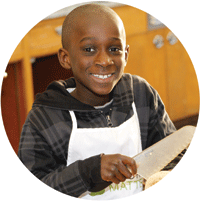
 is the
is the 








